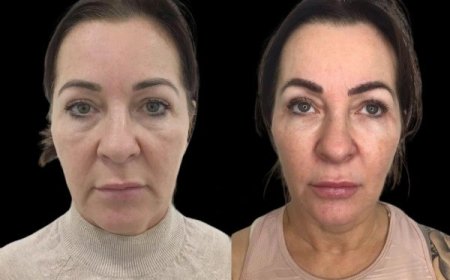The Role of Positive Body Language in Building Strong Relationships
Learn how positive body language enhances communication and strengthens relationships, fostering trust and connection.

In both personal and professional settings, body language plays a crucial role in communication. Its often said that words make up only a small part of how we communicate, while non-verbal cues, like body language, carry the majority of the message. Positive body language can significantly influence relationships by fostering trust, understanding, and rapport. In this blog, we'll explore the importance of body language in building strong connections with others and how it can benefit various aspects of life.
What Is Positive Body Language?
Positive body language refers to non-verbal cues that convey openness, confidence, empathy, and trustworthiness. It includes gestures, facial expressions, posture, eye contact, and even the tone of voice. These signals can either enhance or undermine communication, depending on how they are expressed.
For example, maintaining eye contact during a conversation can indicate attentiveness and respect. Similarly, a firm handshake or a welcoming smile can signal warmth and approachability. On the other hand, crossed arms or avoiding eye contact may suggest defensiveness or disinterest.
Understanding how to use positive body language effectively can help strengthen your personal and professional relationships. Heres how:
1. Building Trust and Credibility
Positive body language is essential for establishing trust. When your body language is open and relaxed, others are more likely to feel comfortable around you. This is particularly important in professional settings, where trust is the foundation of collaboration and teamwork.
For instance, as a St Kilda Dentist, when you meet with your patients, displaying positive body language by maintaining a relaxed posture and showing warmth can help ease their anxiety. This not only builds trust but also encourages long-term relationships with clients, ensuring they feel comfortable seeking your services for years to come.
2. Improving Communication
Communication is a two-way street, and non-verbal signals often convey more than words alone. A friendly smile, a firm handshake, and open gestures all contribute to a positive atmosphere, making conversations flow more naturally. It also allows the other person to feel heard and understood.
In professional environments, such as a dental clinic, creating a positive atmosphere through body language can help make patients feel more at ease. Whether you're discussing treatment plans or simply greeting a patient, the way you express yourself physically can make a significant difference.
3. Boosting Confidence and Reducing Stress
Positive body language also has the power to influence your own emotions and self-esteem. When you adopt confident body language, such as standing tall or speaking with clear enunciation, you can trick your mind into feeling more confident, even if youre nervous.
For example, when interacting with others at work or in social situations, adopting a posture of confidence can make you feel more empowered. Not only does this improve how you are perceived, but it also helps in overcoming stress and boosting self-assurance. This confidence often translates into more meaningful and productive conversations.
4. Creating a Welcoming Environment
Positive body language is also essential for creating a welcoming and approachable environment. A friendly smile, open arms, and a relaxed stance can make others feel more comfortable in your presence, encouraging them to engage more openly. This is particularly important in customer-facing roles, such as in dental practices or any healthcare-related field.
As a Dentist St Kilda, your ability to create a welcoming atmosphere through positive body language can help put patients at ease, especially those who may feel anxious or nervous about their appointments. Simple gestures, like offering a smile or sitting at eye level with the patient, can have a profound effect on their experience and willingness to return for future visits.
5. Building Rapport and Strengthening Connections
Rapport is the foundation of any successful relationship, whether personal or professional. Positive body language, such as mirroring someones gestures or maintaining open posture, can create a sense of connection and mutual respect.
In any relationship, showing that youre attentive and engaged through body language encourages others to feel valued. For example, during a consultation, by mirroring the patients body language or maintaining good posture, you demonstrate that youre fully invested in their concerns. This helps strengthen the relationship and leads to more successful outcomes.
6. Enhancing Non-Verbal Communication Skills
Mastering the art of body language also means becoming more aware of how others use it. This awareness allows you to pick up on subtle cues, such as discomfort or hesitation, which can provide valuable insight into a persons feelings or intentions. In turn, this enables you to adjust your own body language to better match the needs of the situation.
For example, if you notice a patient at your clinic seems uneasy, you might adjust your body language to show more empathyleaning forward slightly or nodding to acknowledge their concerns. This non-verbal cue can make the patient feel more heard and understood.
7. The Power of Listening
Active listening is a critical part of positive body language. By showing genuine interest in what someone is saying through non-verbal cues, such as nodding, leaning in slightly, or maintaining eye contact, you demonstrate that you value their input. This encourages them to share more openly and helps build a deeper connection.
In professional settings, like a dental practice, being an active listener not only enhances your communication with patients but also builds their trust in you. They are more likely to follow your recommendations if they feel you understand their concerns.
Conclusion
In summary, positive body language plays a vital role in building strong relationships. Whether its in personal interactions or professional environments, the way we use our bodies to communicate can strengthen connections, foster trust, and improve overall communication. As a Dentist, mastering positive body language can make a significant impact on patient satisfaction and help create long-lasting relationships. By embracing the power of non-verbal communication, you can transform the way you interact with others, leaving a lasting impression that goes beyond words.





















